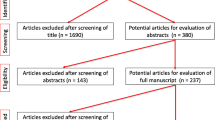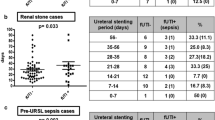Purpose
Abstract
To determine if treatment of non-obstructing urolithiasis is effective in management of recurrent UTI.
Materials and methods
A retrospective review was performed of patients undergoing elective management of non-struvite upper tract urinary calculi with recurrent UTI from 2009 to 2016. Recurrent UTI was defined at ≥ 3 UTI in 12 months, with symptoms and documented urine culture. Preoperative CT was performed in all patients to determine stone burden. All patients had postoperative imaging and ≥ 12 months of follow-up. Pre- and postoperative variables were between patients who had recurrent UTI after treatment versus those who did not.
Results
46 patients met inclusion criteria. 42 (91.3%) were female. Median age was 63.7 years (IQR 49.1, 73.4) and median total stone burden was 20 mm (IQR 14–35). Within the cohort, 20 (43.5%) underwent ureteroscopy only, 26 (56.5%) underwent PCNL ± URS, and none underwent ESWL. Median postoperative follow-up was 2.9 years (IQR 2.0, 4.3). Only five patients (10.9%) had recurrent UTI after treatment. 80% were with the preoperative pathogen. The presence of residual stone was an independent risk factor for recurrent UTI after treatment (p < 0.046). Diabetes, hypertension, immunosuppression and chronic kidney disease were not.
Conclusions
Stone removal for patients with recurrent UTIs was associated with a high rate of success (89.1%) in elimination of further recurrent UTIs. Residual fragments are independently associated with persistent recurrent UTIs and thus, complete stone removal is of paramount importance in treatment of this patient population.
Similar content being viewed by others
References
Foxman B, Barlow R, D’Arcy H, Gillespie B, Sobel JD (2000) Urinary tract infection: self-reported incidence and associated costs. Ann Epidemiol 10:509–515
Mabeck CE (1972) Treatment of uncomplicated urinary tract infection in non-pregnant women. Postgrad Med J 48:69–75
Griebling TL (2005) Urologic diseases in America project: trends in resource use for urinary tract infections in women. J Urol 173:1281–1287
Griebling TL (2005) Urologic diseases in America project: trends in resource use for urinary tract infections in men. J Urol 173:1288–1294
Barr-Beare E, Saxena V, Hilt EE et al (2015) The Interaction between Enterobacteriaceae and calcium oxalate deposits. PLoS One 10:e0139575
Rocha H, Santos LC (1969) Relapse of urinary tract infection in the presence of urinary tract calculi: the role of bacteria within the calculi. J Med Microbiol 2:372–376
Chih-Yen H, Hsing-Lin LIN, Yen-Ko LIN et al (2014) Urinary tract infection in patients with chronic kidney disease. Turk J Med Sci 44:145–149
Varda BK, McNabb-Baltar J, Sood A et al (2015) Urolithiasis and urinary tract infection among patients with inflammatory bowel disease: a review of US emergency department visits between 2006 and 2009. Urology. 85:764–770
Abbo LM, Hooton TM (2014) Antimicrobial stewardship and urinary tract infections. Antibiotics (Basel, Switzerland) 05(3):174–192
Omar M, Abdulwahab-Ahmed A, Chaparala H, Monga M (2015) Does stone removal help patients with recurrent urinary tract infections? J Urol 194:997–1001
Cui X, Ji F, Yan H et al (2015) Comparison between extracorporeal shock wave lithotripsy and ureteroscopic lithotripsy for treating large proximal ureteral stones: a meta-analysis. Urology 85:748–756
Fankhauser CD, Hermanns T, Lieger L et al (2018) Extracorporeal shock wave lithotripsy versus flexible ureterorenoscopy in the treatment of untreated renal calculi. Clin Kidney J 11(3):364–369
de Cógáin MR, Lieske JC, Vrtiska TJ, Tosh PK, Krambeck AE (2014) Secondarily infected nonstruvite urolithiasis: a prospective evaluation. Urology 84:1295–1300
Paonessa JE, Gnessin E, Bhojani N, Williams JC Jr, Lingeman JE (2016) Preoperative bladder urine culture as a predictor of intraoperative stone culture results: clinical implications and relationship to stone composition. J Urol 196:769–774
Author information
Authors and Affiliations
Contributions
DKA: Protocol/project development, Data collection, data analysis, manuscript writing and editing; AEK: Protocol/project development, Data collection, manuscript writing and editing; VS: Data analysis, manuscript writing and editing; FJM: Data collection, manuscript writing and editing; MEW: Data analysis; JJK: Manuscript editing; MER: Protocol/project development, Data collection, data analysis, manuscript writing and editing.
Corresponding author
Ethics declarations
Conflict of interest
AEK—Paid consultant for Lumenis and Boston Scientific. Non-paid consultant for Thermadex. No other authors have disclosures.
Research involving human participants
Appropriate Institutional Review Board approval was obtained for this retrospective review.
Informed consent
An informed consent waiver was approved due to the retrospective nature of this research.
Additional information
Publisher's Note
Springer Nature remains neutral with regard to jurisdictional claims in published maps and institutional affiliations.
Rights and permissions
About this article
Cite this article
Agarwal, D.K., Krambeck, A.E., Sharma, V. et al. Treatment of non-obstructive, non-struvite urolithiasis is effective in treatment of recurrent urinary tract infections. World J Urol 38, 2029–2033 (2020). https://doi.org/10.1007/s00345-019-02977-3
Received:
Accepted:
Published:
Issue Date:
DOI: https://doi.org/10.1007/s00345-019-02977-3




